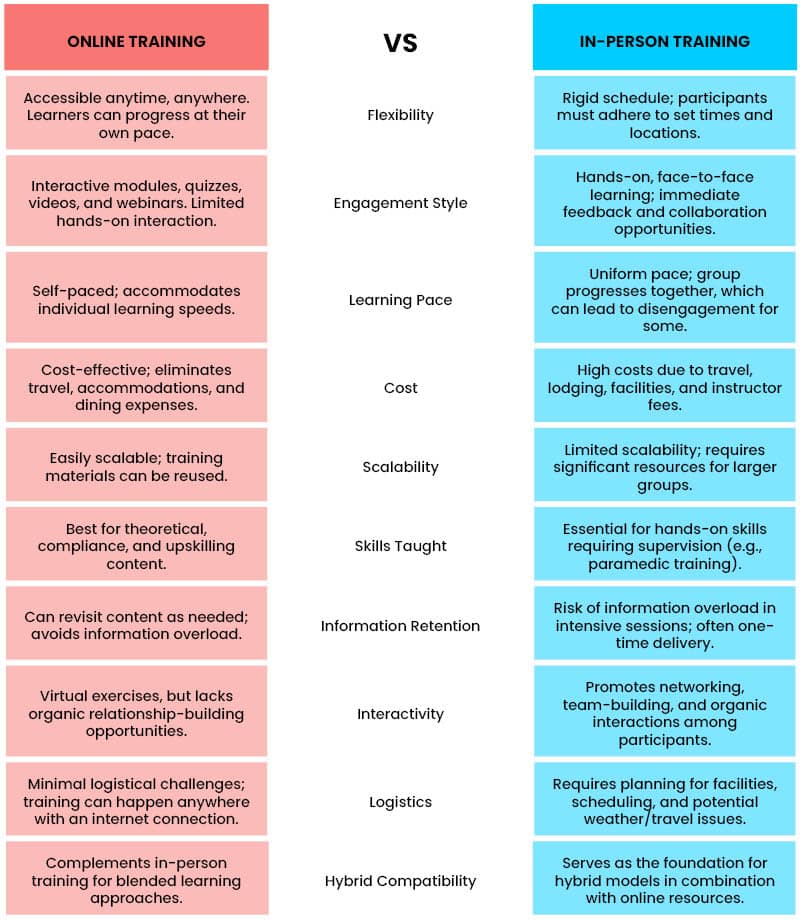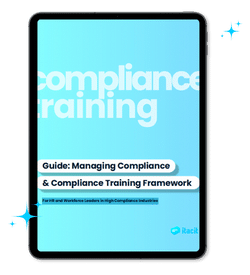Employee training programs are no longer a one-horse race. Before the advent of automation, digital workplaces, and hybrid work, learning and development professionals had few options when it came to providing corporate training for employees. When making decisions about how to provide essential training courses in areas such as new hire on-boarding and critical job training, almost always the decision defaulted to in-person training.
Table of Contents
- Online or In-Person: Which Is Best for My Company?
- Training Formats Explained
- What is In-Person Training?
- What is Online Training?
- What’s Trending in Training?
- Pros and Cons: Online Training vs In-Person Training
TL/DR Download a PDF of this article to read when you are ready!
The Rise of Online Learning
It’s no surprise to hear that online learning has been trending up in recent years given the pace of innovations and the impact of quality of life factors. In fact, some believe it’s become harder to not incorporate virtual training or remote training into their training platform and delivery strategies. This has left many organizations behind the mark when faced with making the critical business decision: is our employee training program going to continue to focus on in-person training or will we adopt online training to align with current trends?
The truth is there is no one-size-fits-all answer.
Every industry and organization has a different set of needs and constraints they must align with. Even when it brings in higher stats for areas like retention and engagement, eLearning can’t always be the first choice – especially for certain skills that can only truly be taught by hands-on demonstrations and tests.
Consider a paramedic’s practical learning: in situations like this, virtual training can never fully replace its in-person alternative. But it can provide plenty of avenues to upskill, fulfill employee compliance and training requirements, and provide a platform for niche and micro learning opportunities which are essential to ongoing employee management and retention.
Online or In-Person: Which Is Best for My Company?
Employee training programs and platforms have become a core business need and cover a wide range of industries – such as healthcare, logistics, manufacturing, enterprise, and government. With technology advancing, regulations shifting, and consumer demands continuously evolving, it’s no wonder key decision makers have become laser focused on investing in employee engagement and knowledge building through ongoing training courses and learning management systems (LMS).
I’ve found benefits (and negatives) for each of these delivery methods – in-person and remote training – throughout my career and aim to equip you and your team of decision makers with a balanced analysis, exploring both advantages and challenges.
So let’s jump right into things and walk through a comparison of the main differentiators you should have on your radar.
Training Formats Explained
Companies have a seemingly endless array of options when it comes to employee development, broadly including traditional learning methods, like in-person training, and virtual training, to more niche areas like mentorship programs and task rotations, to name just a few.
Being a decade or two into my own career, I’ve had the opportunity to engage extensively in both formats, appreciating each for its unique strengths and suitability in various scenarios.
Meeting the challenges of today’s workforce, with hybrid and virtual employment on the rise, makes understanding the key differentiators between in-person and online training a top consideration for nearly every HR professional.
What is In-Person Training?
Most of us are familiar with this classic, instructor-led training approach. Most notably, it’s where trainers and employees gather together in the same physical space to provide hands-on training, participate in face-to-face workshops, and engage in team-building activities.
This format wonderfully supports employee engagement through real-time interactions and immediate feedback. For example, in a healthcare setting, you might see employees practicing patient care techniques through simulations. Or in manufacturing, workers could get hands-on experience with new equipment under a trainer’s guidance.
What is Online Training?
Online training, or remote learning, has moved learning to the digital world, and with it created a slew of alternative online learning formats to suit a wide range of needs. These options, such as eLearning modules, live webinars, and virtual instructor-led training, are super flexible.
Most notably, online training provides an opportunity for each individual to decide when and where to take advantage of employee training programs.
In a logistics company, for example, employees might complete self-paced lessons on supply chain management, while managers join live sessions to tackle strategic topics. In both scenarios, a variety of interactive exercises, like quizzes or videos, might be layered in to enhance employee engagement and improve recall.
What’s Trending in Training?
Online courses and offline methods have evolved significantly in recent years as remote and hybrid work skyrocketed during the pandemic. It was important at the time for organizations to quickly transition to online training experiences but, interestingly, many chose to stick with it due to cost-effectiveness and scalability.
Here are a few key statistics:
- LinkedIn’s 2022 Workplace Learning Report reveals that 74% of Learning and Development (L&D) leaders agree that L&D has become more cross-functional, indicating a significant shift in training strategies.
- While in-person training remains valuable, many companies are adopting hybrid approaches, blending in-person and online methods to maximize flexibility and engagement.
- Industries requiring hands-on skills, such as healthcare and manufacturing, continue to rely heavily on in-person training for competencies that are challenging to teach online, while also developing virtual training methods to complement the overall learning journey.
These trends highlight the complexity and dynamic nature of employee training, and underscore the need for organizations to consider blended learning methods to meet evolving demands.
Online training is accessible anywhere, anytime
As in-person learning has been around for as long as we can all remember, let’s start off with the newcomer.
Mobile elearning solutions give users the freedom to choose when and where they want to learn. It also lets you progress at a pace that is comfortable for you, the learner – not one that is decided by the facilitator.
There are a number of benefits both employers and employees recognize. For employers, online courses and programs provide a training option that can be reused over and over again, recouping valuable time, resources, and costs that can be better allocated to other, more sensitive, areas of the business.
Employees arguably have a lot to gain here as well. Some well documented examples include autonomy over their schedule and learning environment, self-paced training and education, heightened accessibility and collaboration opportunities, and for many it’s a preferred learning style.
Compare that to in-person training where scheduling a group can be a nightmare: conflicting schedules, room and building reservations, challenging weather conditions for commute and travel, personnel overhead for planning and organizing, technological mishaps, and last-minute cancellations are real considerations organizers must contend with.
Worse than that, sometimes work just gets too busy for a group of learners to be released from their work responsibilities to attend a training session, which can be real stressors to both management and the individual contributor.
Today, you don’t have to plan your day around a certification seminar or a live training session: you can pick up your training right in the comfort (and convenience) of your home office or a personal workspace. Because of its easily accessible nature, online learning materials actually result in more learning.
But, don’t think this is always a clear-cut case of ‘in with the new, out with the old’ – you don’t have to completely drop one approach for the other; and nor should you! Some things are simply better taught in person and that deserves further consideration.
In-person training is hands-on and interactive
Compared to online training, classroom-based learning is literally hands-on. You can usually find time either during or after the session to have your questions answered directly by the instructor, and you have a whole room full of opinions and knowledge to draw from.
For some people and in many professions, the personal, hands-on interactivity can be really missed when you’re doing the majority of learning online. What’s more, you can’t replace the physical, hands-on approach for building certain skills. Take paramedics as an example: in emergency medical settings, there is no substitute for the hands-on experience and real-time interaction provided by an in-person placement shift. Online classes cannot fully replicate the critical, real-world skills and decision-making required in these scenarios which require a physical setting.
When using equipment or practicing a psychomotor skill, supervision and access to certain tools are necessary for many types of jobs and positions. It’s extremely difficult for trainers to replicate the same level of interaction and relationship in a virtual environment.
Face-to-face learning also offers people the opportunity to have organic conversations and build relationships in a more traditional way, which can enhance their learning experience and boost retention.
Even in this example which highlights the power of face-to-face learning, there remain plenty of online formats that can complement in-person instructor-led training. Adopting an online format for closely aligned topics that don’t need critical hands-on learning, like upskilling, time-based content refreshes, and compliance programs, could provide a valuable hybrid training option that both improves ongoing employee learning opportunities and the business’ bottom line.

Cost efficiencies of online training
All of those in-person perks like instructors, equipment, and classrooms add up to a cost that can be quite surprising. The cost of in-person training often has to consider transportation, dining expenses, accommodations, and more.
With online training, not only are those real costs eliminated, countless hours of time-on-task can be recovered because users can progress at a rate that they are comfortable with to accomplish the objectives. In group sessions, everyone progresses at the same rate. Imagine you have 100 employees and 50 of them only need 30 minutes to learn the same material takes others a full hour. Why not recoup that time and have them spend it more strategically.
An online environment can also reach a wider audience and the material can be reused time and again. Instead of hiring those expensive lecturers to speak to a small group, you can offer full courses that can be accessed repeatedly by individuals or groups within an organization – at their leisure and when they need it.
Online training is flexible
You can’t beat the flexibility of asynchronous learning.
Virtual learning allows individuals to progress at their own pace that’s comfortable for them and at a time that’s comfortable for them. Some people might prefer to complete a program in small segments while someone else prefers to progress through all at once – and that’s completely fine. Some people may learn best in the morning while others prefer to engage in learning while on a quieter evening shift – also completely fine.
Traditional in-person training has a more rigid, formal schedule. In the past, all trainers have at some point alienated a certain group because the timing or pace didn’t align with the need. The learners who finish quickly often disengage or cause distraction, while the ones who take longer can feel rushed.
In-person training can lead to information overload
Participants in live sessions might be years removed from their last formal training. This can make those marathon training sessions quite a challenge, or at worst a total miss on the greater objective: to gain knowledge and/or up-skill.
These can be disastrous results for an organization having signed off on a big training budget. Being sure to consider the nuance of your business and properly analyze the pros and cons of these training methods can have some very serious business advantages.
In training sessions, it is common practice to limit lectures to 45-minutes when hands-on activities are not included. Short, targeted lectures keep people focused and don’t bury them with information. Information overload can lead to poor retention and a lack of enthusiasm to continue learning.
Not only are some training sessions long and intensive, but they’re also often one-and-done. What happens if you have a new hire a week or two after an expensive in-person training? Wait until the next year? Re-do training for just one person? This type of learning is not sustainable or cost efficient.
Pick and choose or only use one: There’s a place in both for online training
Today, online learning is ingrained as a part of the typical workday for most employees, and is baked right into the employee experience.
Keep the classrooms booked as necessary and list the sessions that have to be done in person, but be sure that you’re making remote learning as accessible and accommodating as it can be by providing appropriate self-paced learning activities online and really committing to blended learning as a core strategy.
Need more help designing a hybrid learning approach at your company? Click here to connect with an expert at iTacit to learn more about strategies and online learning platforms!










